- Kraft Heinz has fallen 15% since hitting 12-month high close May 13
- Earnings growth expected to be slightly negative in coming years
- Wall Street consensus outlook is neutral
- Market-implied outlook is neutral with slight bullish tilt to early 2023
- If you’re interested in upgrading your search for new investing ideas, check out InvestingPro+
- Inflation
- Geopolitical turmoil
- Disruptive technologies
- Interest rate hikes
Shares of global food and beverage giant, Kraft Heinz (NASDAQ:KHC) have fallen more than 14% since reaching a 12-month high closing price of $44.29 on May 13.
The shares rallied early in 2022, posting a total return of +7.6% thus far on hopes that the company could maintain margins, even with rising inflation. However, the trailing 12-month total return is -9.2%, as compared with -6.3% for the packaged foods industry as a whole.
As consumer prices continue to rise, and the Pittsburgh-based food supplier faces pressure to raise the costs of its products as well as contend with supply-chain challenges, there is an increased likelihood that customers will shift to lower-cost store brands.
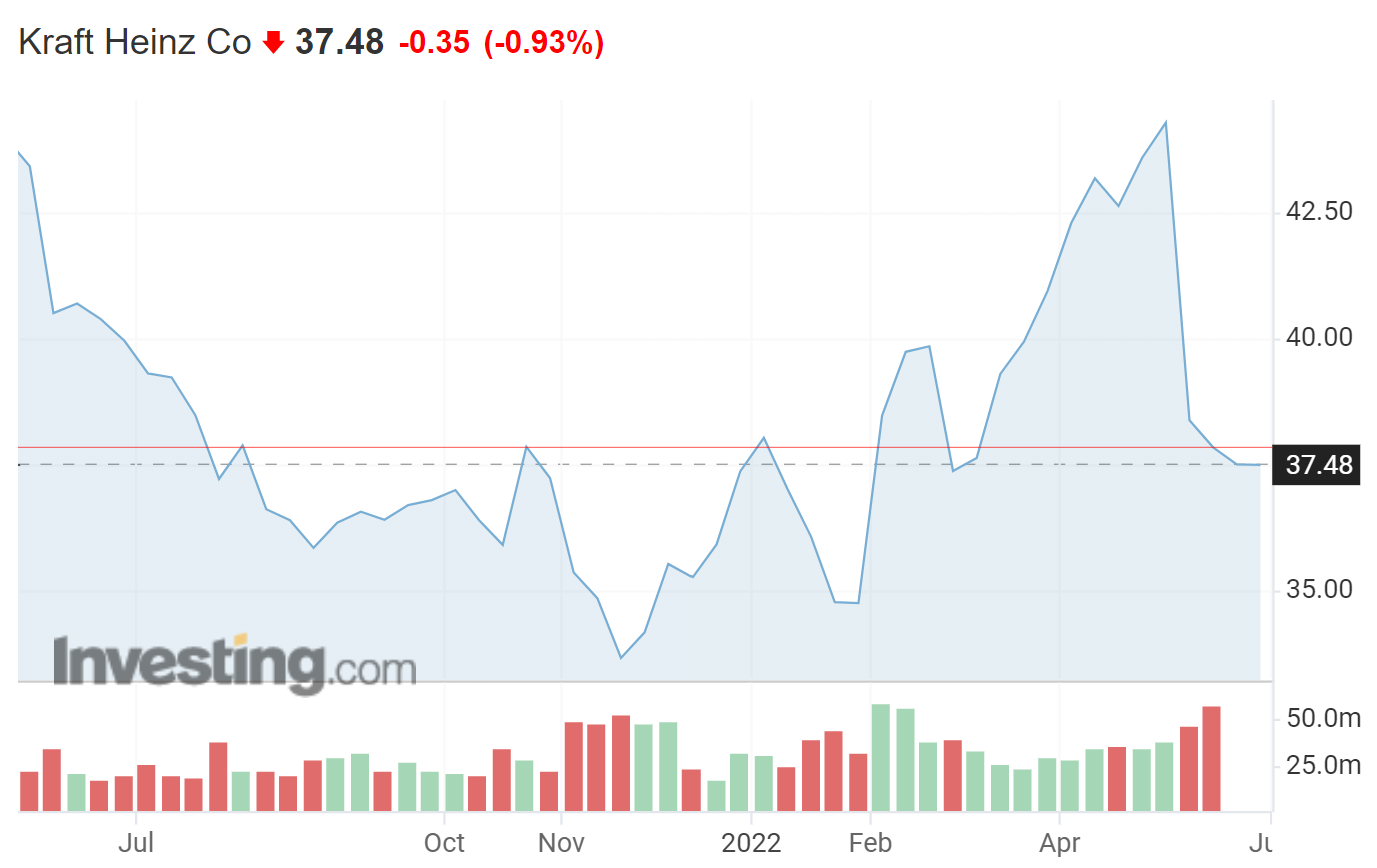
Source: Investing.com
While KHC has beaten earnings expectations for 12 consecutive quarters, there is no evidence of a shift to earnings growth over the past four years. The consensus outlook is for a slight downward trend in EPS (-0.72% per year) over the next three to five years. The company has not yet been able to realize the expected benefits to scale since Kraft and Heinz merged in 2015.

Source: E-Trade. Green (red) values are amounts by which quarterly EPS beat (missed) the consensus expected value.
KHC’s current dividend yield is quite high, at 4.23%. The dividend has been constant since 2019, following a substantial 36% dividend reduction from 2018 levels. While the dividend cut was perceived as necessary for strengthening KHC’s balance sheet, income investors tend to avoid companies without consistent dividend growth histories.
On Nov. 17, I maintained a neutral/hold rating on the stock. Today, the share price is almost identical to what it was then. At that time, the key concerns were the same as they are today: inflation, supply-chain disruption, and lack of earnings growth. The Wall Street consensus rating was neutral and the consensus 12-month price target was about 7% above the share price at that time. Combined with the (then) 4.3% dividend yield, the consensus for expected total return over the next 12 months was 11.3%, but this was not sufficiently high relative to the expected risk (annualized volatility of 25.3%) to indicate an attractive risk-return tradeoff.
In addition to the Wall Street consensus outlook and the fundamentals for a stock, I also rely on the market-implied outlook, which is the consensus view implied by the prices of options on that stock. For my analysis in November, the market-implied outlook to mid-2022 was neutral to slightly bearish.
For readers who are unfamiliar with the market-implied outlook, a brief explanation is needed. The price of an option on a stock reflects the market’s consensus estimate of the probability that the stock price will rise above (call option) or fall below (put option) a specific level (the option strike price) between now and when the option expires. By analyzing the prices of call and put options at a range of strike prices, all with the same expiration date, it is possible to calculate the probable price forecast that reconciles the options prices. This is the market-implied outlook. For a deeper discussion than is provided here and in the previous link, I recommend this outstanding monograph published by the CFA Institute.
I have calculated the market-implied outlook for KHC to early 2023 and I compare that with the current Wall Street consensus outlook in revisiting my overall rating.
Wall Street Consensus Outlook for KHC
E-Trade calculates the Wall Street consensus outlook for KHC by combining the views of 10 ranked analysts who have published ratings and price targets over the past 90 days. The consensus rating is neutral, as it has been for all of the past year, and the consensus 12-month price target is 11.7% above the current share price.
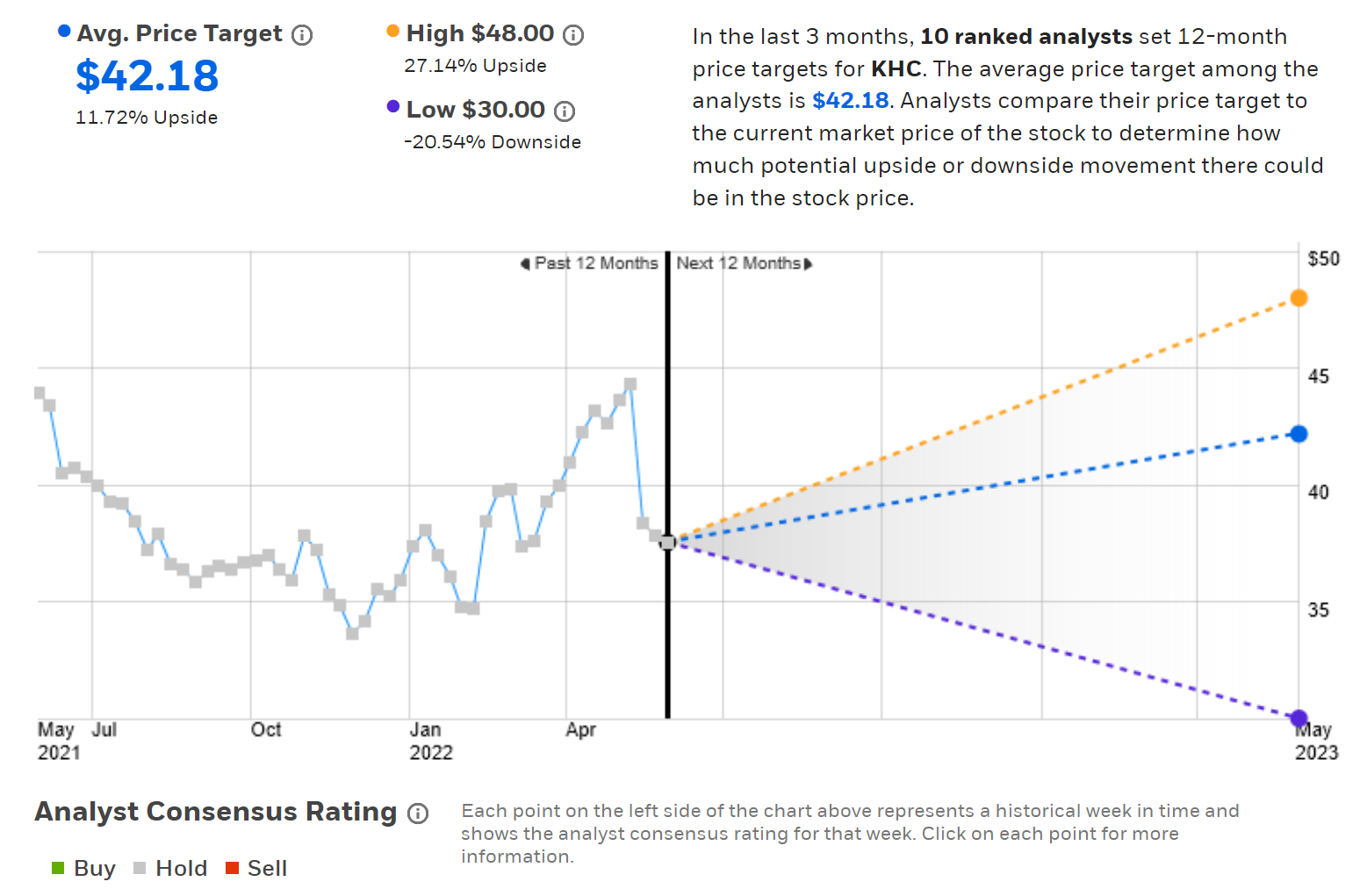
Source: E-Trade
Investing.com’s version of the Wall Street consensus outlook is based on ratings and price targets from 20 analysts. The consensus rating is neutral and the consensus 12-month price target is 13.5% above the current share price.
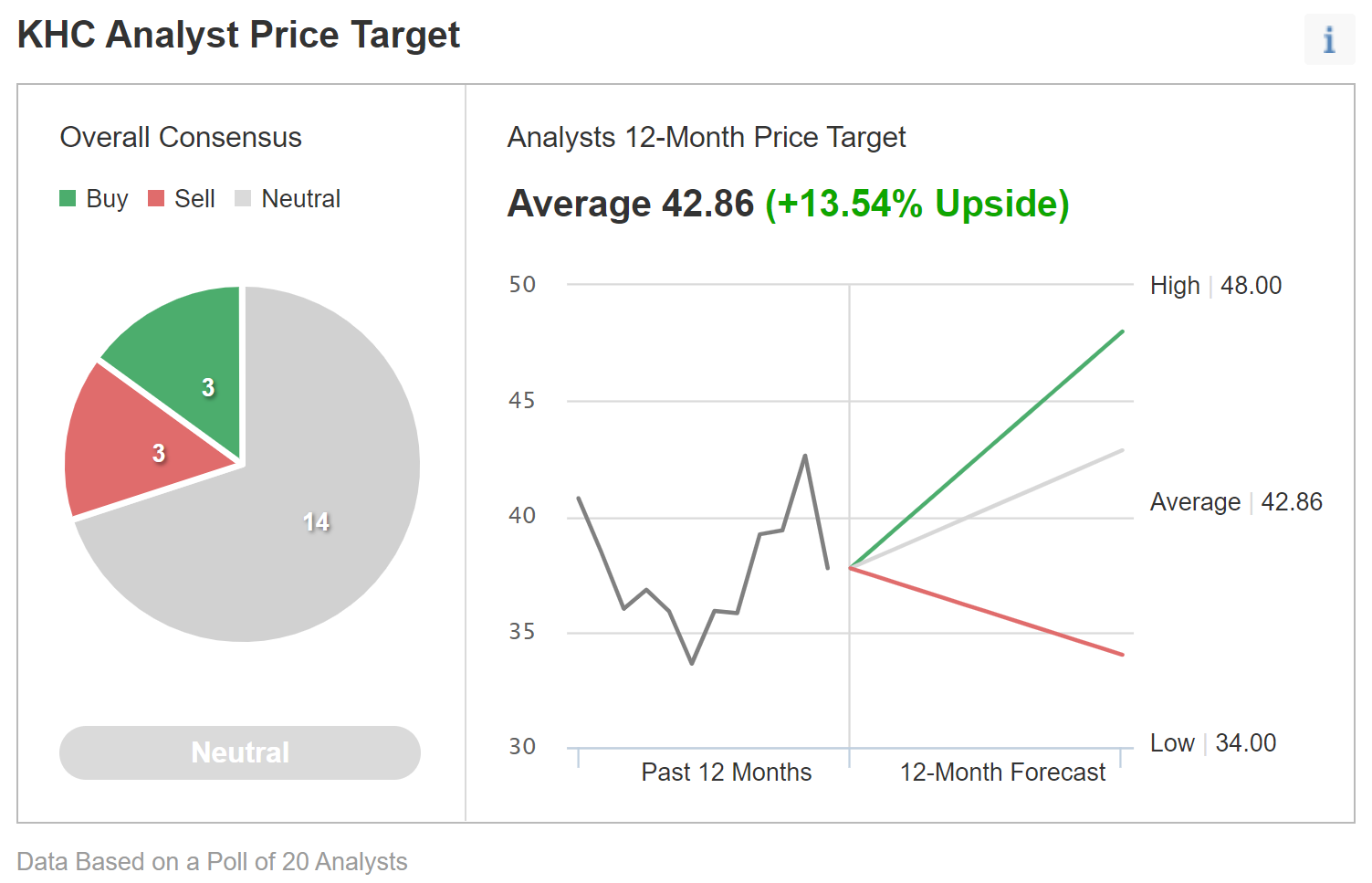
Source: Investing.com
The consensus outlooks generated by E-Trade and Investing.com are very similar, with a neutral rating. The average of the two consensus price targets is 12.6%, for an expected 16.8% total return over the next year.
Market-Implied Outlook For KHC
I have calculated the market-implied outlook for KHC for the 7.6-month period from now until Jan. 20, 2023, using the prices of call and put options that expire on this date. I chose to analyze options with this expiration date to provide a view through the end of the year and because the options expiring in January tend to be among the most actively traded.
The standard presentation of the market-implied outlook is a probability distribution of price return, with probability on the vertical axis and return on the horizontal.
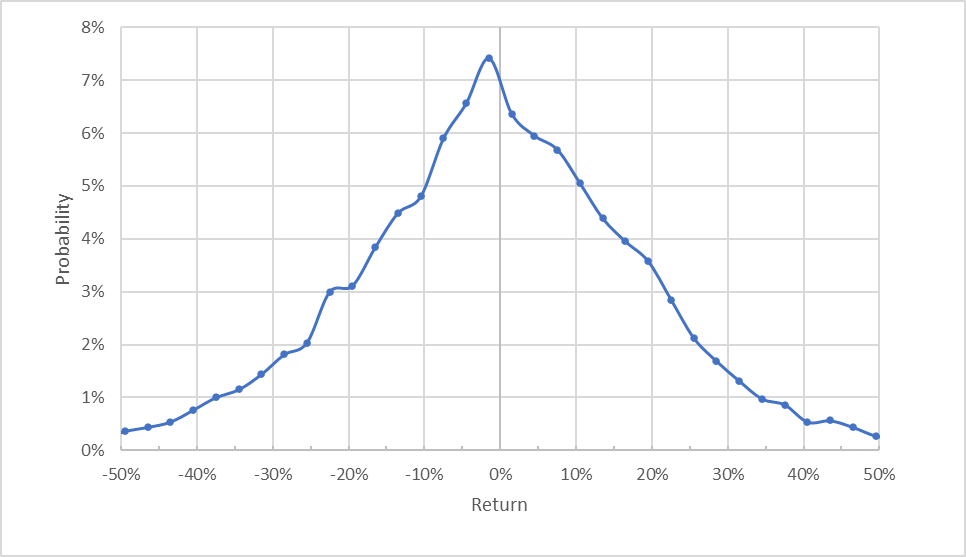
Source: Author’s calculations using options quotes from E-Trade.
The outlook to Jan. 20, 2023, is generally symmetric, with comparable probabilities for positive and negative returns of the same magnitude, although the peak probability is slightly tilted to favor negative returns. The maximum probability outcome corresponds to a price return of -1.5%. The expected volatility calculated from this outlook is 32.3%.
To make it easier to directly compare the probabilities of positive and negative returns, I rotate the negative return side of the distribution about the vertical axis (see chart below).
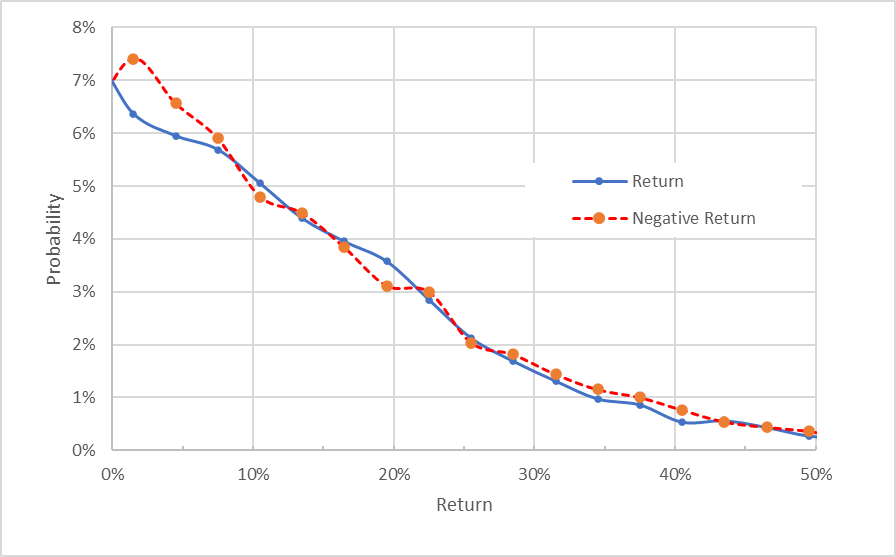
Source: Author’s calculations using options quotes from E-Trade. The negative return side of the distribution has been rotated about the vertical axis.
This view shows that, aside from a small range of outcomes, the probabilities of positive and negative returns match very closely (the solid blue line and the dashed red line are almost on top of one another, other than for returns in the range of +/- 7%).
Theory suggests that the market-implied outlook will be negatively biased, relative to investors’ true expectations, because investors tend to be risk-averse and, as a result, will pay more than fair value for downside protection (put options). There is no way to measure the magnitude of this effect, however. In light of the potential for this bias, I interpret this market-implied outlook to be neutral to slightly bullish.
Summary
Kraft Heinz continues to struggle to monetize its increased scale since Kraft and Heinz merged. Current challenges from inflation and supply-chain disruptions have not helped. The company continues to execute quite well, given the challenges. Whether or not the company can build some positive earnings growth momentum remains to be seen.
For income investors, the lack of dividend growth is a negative, despite the fairly high current yield.
The Wall Street consensus outlook continues to be neutral, with a consensus 12-month price target that corresponds to an expected total return of 16.8%. As a rule of thumb for a buy rating, I want to see an expected total return that is at least half the expected volatility (32.3% annualized, in this case). KHC is right on this threshold.
The market-implied outlook for KHC is neutral, with a slight bullish tilt. While the consensus price target and the market-implied outlook suggest a slightly favorable view, Kraft Heinz’s longer-term struggles to grow earnings and the current headwinds related to inflation convince me to maintain my overall neutral rating.
***
The current market makes it harder than ever to make the right decisions. Think about the challenges:
To handle them, you need good data, effective tools to sort through the data, and insights into what it all means. You need to take emotion out of investing and focus on the fundamentals.
For that, there’s InvestingPro+, with all the professional data and tools you need to make better investing decisions. Learn More »
